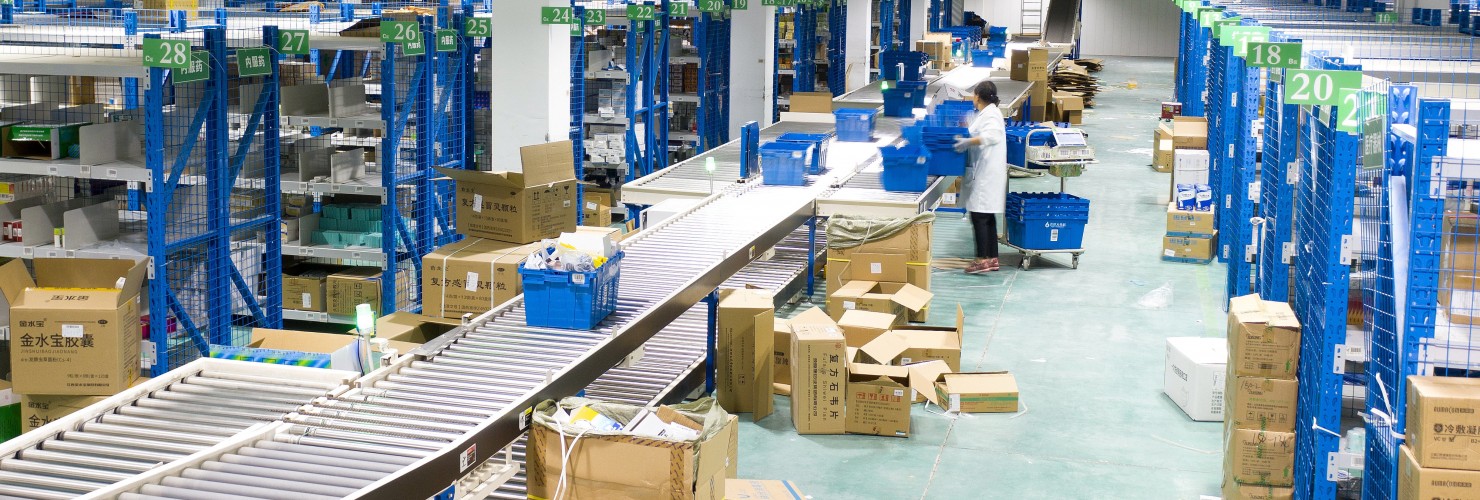

GDP growth weakens in Q4 ahead of a high-stakes year
MERICS Economic Indicators Q4/2021
MERICS Q4 analysis
China’s quarterly GDP growth continued to slow, expanding by 4 percent in Q4. Strong growth early in the year delivered annual GDP growth of 8.1 percent, a result that was easily within the government’s cautious 6 percent target. Growth is unlikely to pick up any time soon as Covid-19 outbreaks linked to Chinese New Year and the Winter Olympics seem inevitable. Any lockdowns will dampen consumption and may disrupt supply chains. In addition, the financial troubles in the real estate sector are far from over.
Lower Q4 GDP growth and the downward economic pressures must be seen in the context of government reluctance to unleash massive stimulus. Instead, the government’s policy actions in Q4 have cut economic growth; these range from heavier regulation in the tech sector, to cutting carbon emissions and curbing financial risks. Policy priorities are always likely to be adjusted over time, but the government seems increasingly willing to pay economic costs to achieve policy goals.
It was therefore no surprise that the government used the Central Economic Work Conference in December to emphasize stability rather than faster growth. In 2022, stimulus measures will be targeted ones that focus on areas vital to China’s long-term strategic goals, such as upgrading industry, greater supply chain security, digitalization, and science and technology.
Meanwhile, China’s business environment is undergoing a fundamental shift as the Chinese Communist Party (CCP) takes an expanding role. Companies are under growing pressure to conform to national strategic goals. As a result, business decisions will increasingly be governed by political patronage and rent-seeking rather than market forces as the CCP reshapes the parameters of economic activity.
China’s policy choices are likely to come at the expense of rebalancing the economy towards more consumption – at least in the short run. Thus far, the consumer internet, tutoring, the entertainment sector, and speculative investment in real estate have all felt the impact of the shift. Crackdowns on these sectors give the impression that the latest buzz word policies – Dual Circulation and Common Prosperity – are likely to be put on the backburner, at least when it comes to strengthening consumption.
Ironically, China has benefited from strong consumer demand abroad while domestic consumption continues to struggle. Persistent high exports produced record trade surpluses which gave a much-needed boost. Net exports contributed the highest share to quarterly GDP growth in more than two decades.
In politics, 2022 will be a crucial year as President Xi Jinping seeks a third term at the CCP’s 20th Congress in the autumn. Growth is unlikely to be allowed to fall off a cliff. However, President Xi’s policy choices suggest a long-term view, focused on reducing risks and vulnerabilities, to strengthen China’s capacity to face future challenges. Short-term stimulus measures are likely to remain restricted to prioritizing stable employment. If necessary, such measures could include more infrastructure building, or delays to some more restrictive policies, such as cutting carbon emissions or shaking out the highly leveraged real estate sector.
The MCCI was first developed in Q1 2017.
Macroeconomics: Policy easing underway as GDP growth slows over Q4
- China’s economy has suffered extreme volatility during its emergence from the crisis triggered by the pandemic in early 2020. Although 2021 began with stellar first half, GDP growth slowed to 4 percent in the fourth quarter, the lowest quarterly expansion on record apart from the first two quarters in 2020. However, annual GDP growth was 8.1 percent, the highest in ten years.
- The pattern of GDP growth in Q4 was strikingly different from previous years (see exhibit 1). In a slowing economy, consumption contributed 85.3 percent to GDP growth despite the ongoing weakness of household spending. Strong foreign demand meant net exports accounted for an unusually high share, at 26.4 percent.
- The investment share of GDP growth tumbled from 22.5 percent in Q1 to pulling down growth by 11.6 percent in Q4. Overall in 2021 gross capital formation’s share of GDP growth fell to its lowest level since 1990, at 13.5 percent.
- The weak showing resulted from the government’s regulatory crackdown on highly leveraged real estate developers, and decision to hold back on infrastructure investment, which dragged down construction activity. After contracting 1.8 percent in Q3, the situation worsened in Q4: construction growth was down by 2.1 percent year-on-year (see exhibit 2).
- Shortages in manufacturing and services, energy shortages, and regional lockdown measures compounded weak domestic demand during Q4 and hurt growth in both manufacturing and services. Manufacturing growth slowed to 3.1 percent in Q4, down from 4.6 percent in the previous quarter. Growth in services fell to 4.6 percent, down from 5.4 percent.
- The government appears more accepting of lower GDP growth levels if they reflect efforts to tackle ongoing structural challenges. However, as the slowdown is broadening to all sectors, government concern about growth prospects for 2022 has prompted looser monetary and fiscal policy. Investment should gradually contribute more to GDP growth as a result.
What to watch: Investment is likely to recover as more stimulus measures are rolled out.
Business: Industrial production improves slightly in Q4 after slowdown
- The fourth quarter saw a recovery in value-added production growth. Headline growth improved to 4.3 percent in December, year on year. At its weakest point in 2021, headline growth had slowed to 3.1 percent at the end of Q3. Weak domestic demand and energy shortages dampened output in 2021. Overall industrial production bounced back, with output for the year 9.6 percent higher, compared to 2.8 percent growth in 2020.
- The uptick in value-added production was supported by a sharp recovery in mining, which climbed to 7.3 percent (see exhibit 1). Following energy shortages in Q3, monthly production of crude coal and natural gas both rose to new peaks in December; coal output reached 384 million tons and natural gas output hit 19.2 billion cubic meters. The government increased coal output by loosening regulation and bringing old mines back into operation.
- Manufacturing output improved steadily over Q4, quenching fears that power cuts would cause a prolonged industrial downturn. Production growth remained strong in high-tech manufacturing and ICT, while automotive output returned to growth by the end of the year (see exhibit 2).
- Output growth in energy-intensive industries has fallen rapidly since Q2 2021, hit by the construction slowdown and short-lived energy shortages. December’s data suggests an end to the downward spiral. Value-added output for cement and crude steel fell less steeply than in previous months, with cement down 11.1 percent year-on-year and crude steel down 6.8 percent. The more muted falls may be an early sign of recovery, as the government has begun to roll out stimulus measures.
- The service sector remains hard hit by Covid-19 lockdowns. Restaurants and travel-related businesses are particularly vulnerable (see retail). It was a brighter picture in logistics-related services as freight turnover rose 11.5 percent in the first 11 months (the last period for which data is available). However, service sector growth is likely to remain weak in Q1 2022.
What to watch: The growth in construction material output may point to the start of government stimulus to help the economy get off to a good start in 2022.
International trade and investment: Exports remain China’s key growth driver as trade surplus hits new record
- China’s exports continued to benefit from strong global demand, providing the economy with much needed support. Full year 2021 exports expanded by 29.9 percent, the highest growth since 2010. Growth eased over Q4 compared to the start of the year, but export growth remained above 20 percent in USD terms on a year-on-year basis.
- Demand for consumer goods and electronics was the strongest factor driving exports higher. For example, exports of toys and mobile phones accelerated in Q4; toy exports rose by 23.5 percent year-on-year in December and mobile phones were up 33.6 percent. Higher Covid-19 cases also generated greater demand for related medical products, including masks and tests; exports of medical products in December increased by 9.3 percent from a high base in the same month of 2020.
- The EU was China’s second most important export destination after the US in 2021: 15.4 percent of China’s exports went to the EU; 17.1 percent headed for the US; and 14.4 percent were destined for ASEAN, China’s third most important market.
- Imports recovered after weak growth in Q3, and improved overall after a dismal 2020 when they contracted by 1.1 percent. In 2021, import growth rebounded to 30.1 percent. But import growth has been losing steam over the second half of the year as more restrictive policies have affected demand for commodities, including iron ore (see exhibit 2).
- Demand for energy commodities, including natural gas and coal, surged in Q4 as the government sought to prevent supply shortages during the winter months and overcome the energy shortages that hit the economy in Q3 (see exhibit 2).
- Foreign direct investment surged to record high of USD 173.5 billion in 2021, up 20.2 percent on 2020. The increase took place despite rising geopolitical tensions. Companies appear to be to onshoring operations to tap into new opportunities provided by China’s latest opening up measures.
What to watch: Rising inflation in the US and the EU risks denting demand for China exports.
Financial markets: Central bank takes cautious steps in support of growth
- Growth of outstanding CNY loans continued to fall over Q4. CNY loans had their lowest monthly growth rate since 2002 in December, expanding by 11.6 percent. However, overall 2021 bank lending hit a record CNY 19.95 trillion. In addition, total social financing (TSF), a broader measure capturing aggregate credit and liquidity, accelerated to 10.3 percent in December, up from 10 percent at the end of Q3.
- The Peoples Bank of China (PBOC) responded to concerns over sluggish economic growth with a moderate shift towards looser monetary policy. During Q4, several key interest rates were cautiously lowered (see exhibit 1). In addition, the PBOC reduced the reserve requirement ratio (RRR) for small, medium and large financial institutions by 5 basis points, the second such move following previous cuts in July.
- Regulators will try to strike a careful balance between supporting economic growth and containing financial risks in highly leveraged sectors. The government will likely relax constraints on local governments, allowing them to boost infrastructure spending. However, it will seek to encourage investments geared towards industrial upgrading. But the real estate sector will face continued pressure to deleverage and should only expect relaxation as a last resort to boost the economy.
- The risk build up is far too serious for the government to ignore. Bloomberg data indicates record monthly offshore bond defaults in December, with real estate developers accounting for half (see exhibit 2). Higher borrowing costs and falling real estate prices has resulted in several developers requesting payment extensions in order to prevent defaults.
- Boosted by a massive current account surplus and persistent financial inflows, the USD/CNY exchange rate appreciated more than 2 percent over 2021 to end the year at 6.38 CNY to the dollar. As long as inflows to China remain strong, the CNY is likely to appreciate further despite potential interest rate divergence in the United States or the Euro area.
What to watch: Further monetary adjustments will indicate the government’s confidence level towards the economy.
Investment: Economic fallout from the real estate crackdown is still unfolding
- Fixed asset investment expanded by 4.9 percent in 2021 compared to 2020, delivering the second lowest growth rate on record. The lowest was in 2020. Investment continued to slow over the final quarter of the year and was below the five-year average of 5.8 percent. The slowdown in FAI stems from the government´s emphasis on reducing financial risk within China’s economy and reluctance to roll out stimulus measures.
- Weak investment growth owed a lot to the slowdown in real estate investment amid a government crackdown on highly leveraged developers. By the end of 2021, real estate investment growth had dropped to 4.4 percent compared to 2020 (see exhibit 1) and was far below the pre-pandemic growth rate of 9.9 percent in 2019. More policy finetuning can be expected in order to limit the economic fallout in the months ahead.
- Independent of policy adjustments, the fallout in the real estate sector will continue to drag down economic growth. The real estate sector is still busy completing existing projects. In 2021, projects under construction rose 5.2 percent year-on-year, whereas new construction starts slumped in the last two quarters, down by 11.4 percent by the year’s end.
- So far, infrastructure spending has not been used to stimulate the economy as local government finances have been targeted by the nationwide deleveraging campaign since 2017. Spending on infrastructure rose a mere 0.4 percent in 2021. Infrastructure spending is likely to increase in 2022. However, financial constraints will be placed on investment in railway and highways.
- New stimulus measures are more likely to prioritize the construction of “new infrastructure” and advanced manufacturing to strengthen China’s future competitiveness. The policy emphasis on upgrading industry is reflected in strong investment activity in the machinery and equipment sectors; where average investment increased by 19.9 percent in 2021 (see exhibit 2).
What to watch: Infrastructure spending is good indicator of the government´s bottom line for GDP growth, so watch for the strength of any uptick.
Prices: Lower inflation leaves room for a more expansive fiscal and monetary policy
- Inflation pressure subsided during the final quarter of 2021, giving the government more leeway to roll out stimulus measures to support the economy. Inflationary pressures for consumers and producers alike remain concentrated in elevated fuel and energy prices, though price rises began to ease in Q4 (see exhibit 1)
- Energy shortages in Q4 pushed China’s Producer Price Index (PPI) to its highest level since 1995, peaking at 13.5 percent year-on-year in October. But the PPI cooled after government action to ramp up coal production ahead of winter and curb price speculation.
- Energy-intensive sectors remain hardest hit by inflation, with price increases above 20 percent. Factory gate prices for chemical raw materials rose 23.8 percent in December, year-on-year, and ferrous metal processing prices jumped 21.4 percent year-on-year. Less energy-intensive manufacturing suffered from slack demand. Factory gate prices for communication and electronic equipment rose only 1.6 percent year-on-year, while automobile prices were up only 0.3 percent.
- Consumer prices reached a 15-month high in November, up 2.3 percent year-on-year. However, this reflected the weak baseline of November 2020, higher energy costs and the surge in fresh vegetable prices. Extreme weather conditions damaged staple vegetables so prices jumped by more than 30 percent. For 2021, the consumer price index (CPI) rose only 0.9 percent, the lowest increase since 2009.
- The real estate sector’s struggles in 2021, involving developers’ financial difficulties and a crackdown from regulators, have begun to affect housing prices (see exhibit 2). Prices have been falling steadily over the quarter, starting to contract in October compared to the previous month. The price falls are partly due to struggling developers offering discounts to buyers to stay afloat. The average price index for a new residential apartment contracted by 0.2 percent in December compared to the previous month.
What to watch for: Any recovery in housing prices after the financial crunch of late 2021.
Labor market: Weak employment data could accelerate stimulus measures
- Stable employment remains one of the government’s top concerns, as GDP growth has continued to slow. Unemployment stood at 5.1 percent at the end of 2021 compared to 5.2 percent in both December 2020 and December 2019. With the unemployment rate only fractionally lower than pre-pandemic levels, the government continues to emphasize the roll out of new programs to ensure stability.
- During 2021, 12.7 million new urban jobs were created, up from 11.7 million in 2020. But the better annual comparison masks some underlying challenges in the labor market. New employment remains below 2019 figures, when 13.5 million new jobs were added. More importantly, only 2.2 million new jobs were created in Q4 this year, well below 2.9 million in 2020.
- Job seekers have responded to heightened economic insecurity and the tougher demands in the labor market by turning to stable government jobs. The numbers applying to take the civil service entry exam rose 37.4 percent in 2021, to 2.1 million (see exhibit 1).
- The Ministry of Education estimates China has a deficit of 30 million skilled workers, who are needed to fill high-tech manufacturing roles, including in new materials, machine tools and new energy vehicle (NEV) production.
- The record number of university graduates seeking jobs will add to the pressure in 2022. Record numbers have become the norm in recent years as the number of college-educated Chinese keeps rising. Even so, this year’s jump is significantly higher than in previous years: 10.8 million graduates are expected to join the labor market in 2022. This compares with1.7 million in 2021 and 0.3 million in 2020.
- Real disposable income grew by 8.1 percent in 2021, in line with overall GDP growth. But the outlook for wage growth remains pessimistic (see exhibit 2). Expectations on future wage growth are still below 2019 levels, indicating underlying insecurity about the economy.
What to watch: New urban employment will be a key variable for the government when considering broader stimulus measures.
Retail: Consumption is unlikely to pick up soon as spending disappoints in Q4
- Retail growth improved to 12.5 percent in 2021 after a dismal year in 2020, but overall consumption continued to disappoint. An uptick in spending in October proved to be short lived. After rising to 4.9 percent at the beginning of the quarter, growth dropped to 1.7 percent in December year-on-year, a 14-month low (see exhibit 1).
- Multiple factors continue to dampen consumers’ willingness to spend. New lockdowns in Q4 stoked consumers’ caution, along with slower wage growth, higher energy costs, and scant official efforts to boost consumption. Although global demand for China’s consumer goods is driving exports, China’s own consumers are holding back: spending fell in key categories in December, including textiles and electronics, making for a weak end to the year (see exhibit 2).
- Automobile sales continued to contract in Q4, though there were signs of improvement. After dropping by 11.8 percent in September year-on-year, the decline slowed to 7.4 percent in December. Any significant improvement in consumer spending depends on strong automobile sales, as they account for around 10 percent of total retail spending.
- Online spending rose rapidly early in 2021, helping to lift consumption in the year’s opening months, but the impact steadily diminished as the year unfolded. In Q4, online spending growth dropped below 2019 levels. In 2021, it expanded 14.1 percent year-on-year, down from 16.5 percent at the end of 2019. The online share of total retail has risen by around 5 percentage points from pre-Covid levels, but it dipped to 24.5 percent in 2021 from 24.9 percent in 2020.
- China’s transportation and travel related services remain in a dire state. The rebound came to a halt in August with the first wave of renewed local lockdowns. The final quarter proved to be the worst in 2021 for the railway passenger numbers: year-on-year growth dropped by 20.8 percent.
What to watch: Chinese New Year spending will be the key indicator of consumer sentiment in the next quarter.


